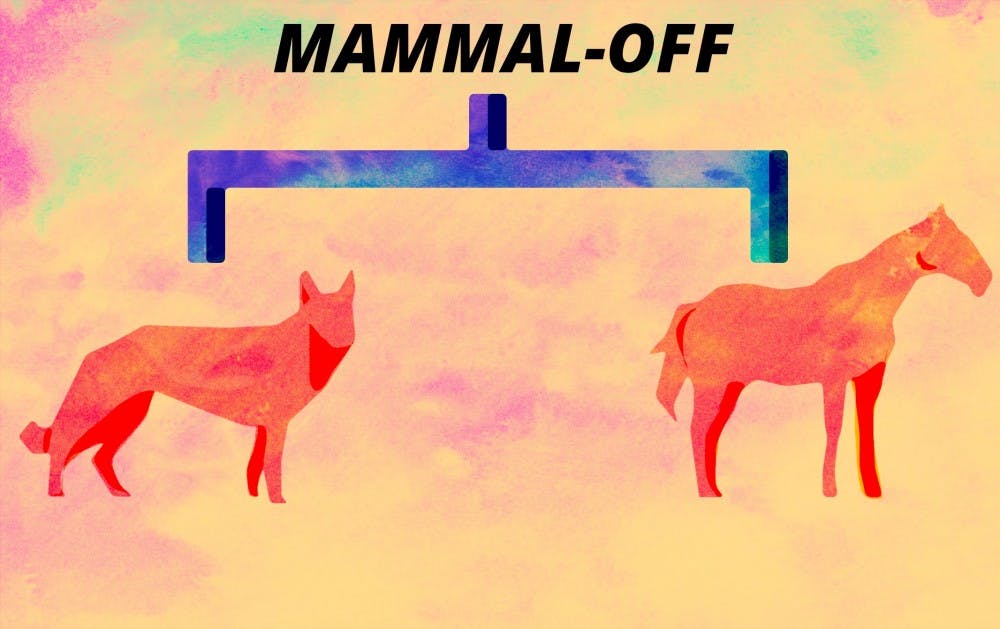For the sixth year in a row, fans of competition, matchup predictions and upsets have gathered to create a bracket for March Mammal Madness – this year with the thrill of play-by-play and controversial contestants.
March Mammal Madness, a 64-animal bracket that pits creatures against each other in hypothetical battle, began in 2013. The competition was started by Katie Hinde, an ASU professor and chair of the executive committee in the School of Human Evolution and Social Change, while she was at Harvard University.
The initial bracket came out on March 1, and the tournament is currently in the Sweet 16.
Similar to the NCAA’s March Madness, competitors are seeded, one through 16. Each competitor is ranked on its set of skills, which determines seeding, then a random number generator determines victors based on the chances of a victory. If one-seed has a 94-percent chance of victory, it will win if the number generator chooses a number between 1 and 94.
This year marks the first year that non-mammals (#altmammals) were allowed into the tournament, with the Orinoco Crocodile as the one-seed in the ‘When the Kat’s Away’ bracket, where it has bested a praying mantis and goliath tarantula to advance to the round of 16.
In 2015, the tournament included mythical mammals, such as a Yeti and a Unicorn. Hinde said in an email that the controversies surrounding their inclusion was comparable to this year's inclusion of non-mammals.
“Both created a bit of a furor, but mostly people were into it!" she wrote in the email. "Mythical mammals, like the Yeti or the Unicorn, aren't real, but they are based on exaggerated or recombined features of real animals that are dangerous or useful. And the ability for humans to imagine these animals and tell stories (and believe those stories) about mythical animals reflect human adaptations for abstract cognition and social learning.”
Hinde refrains from creating a bracket herself, worrying it would influence her decision-making for matchups. She said that throughout the years, several upsets have caused controversy, but that it's largely a part of the game.
"I think folks were really upset this year when in the first round, the 13th-seed mantis shrimp's double impact punch took out the 4th-seed alligator snapping turtle," Hinde wrote in an email. "Also folks are still talking about the platypus going down in round 1 – everyone got so excited about their venomous spurs that they didn't check the expiration date – platypus are only venomous during mating season. The glands that produce the venom are very shriveled in March, and the platypus was only shooting blanks against the maned rat."
The competition in 2018 marks the first year to include sports summaries that dramatize the potential battles between the creatures.
Jessica Martin, a junior studying anthropology and sustainability, and Jason Krell, the communications and event coordinator for the Center for Evolution and Medicine, both wrote summaries.
The summaries include headlines like “SPIDEY SENSES NOT TINGLING ANYMORE” and write-ups that tell how the tarantula’s “underdog run was ended in a single bite.”
Martin said that she approached Hinde, who was a guest lecturer for her anthropology class, and offered to begin writing summaries.
“I thought it sounded like a lot of fun, I’m a huge animal lover and I also think social media is a great way to get people interested in science,” Martin said.
Krell said once the fights are decided, he begins on summaries.
“Once they know who the winner is, they’ll assign that battle to a scientist and they get to write up a mock battle which they get to come up with,” Krell said. “So they already know who the winner is going to be, but they get to use a little creativity using the certain traits the animals have.”
Martin, an Air Force veteran, said the hardest part of doing the competition’s write-ups, besides trying to sneak in as many puns as possible, is deciding what all goes into each summary.
“I write these articles for everyone, but I do keep in mind that a lot of the March Mammal Madness stuff is seen by school-age children,” Martin said. “So I tailor them accordingly, I don't put anything in there I wouldn't want a kid to read.”
Martin said that it’s hard choosing a favorite to win this year because there are so many strong contenders each with their own unique characteristics
“If I had to choose a favorite, it would either have to be the Berlin Boar or the Pygmy Hippo,” Martin said. “If I had to choose my biggest upset though, it would have to be the Aye-Aye losing to the Cheetah, the Aye-Aye was my original favorite, he’s hideous but I love him!”
Krell has his eyes set on the technical win, favoring the extinct Amebelodon, but said he’s still got hopes for the Tardigrade.
The Sweet Sixteen competition took place on Wednesday, March 28, with the Elite ‘Trait’ the next day and the championship on Wednesday, April 4.
Reach the reporters at maatenci@asu.edu and amville8@asu.edu or follow @MitchellAtencio and @AustinMVillegas on Twitter.
Like State Press on Facebook and follow @statepress on Twitter.




